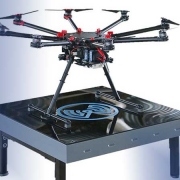Article: Wireless Charging to Bring ‘True Autonomy’ to Mobility Era in Robotics
This Q&A with Paul Wiener, VP of Strategic Marketing at GaN Systems, was originally published in its entirety on Robotics Tomorrow on December 10, 2019.
Imagine a factory floor with fast wireless charging pads or stations that doesn’t require a human operator to make a physical connection and placed strategically around a facility to enable maximum uptime.
Tell us a bit about GaN Systems and your role in the robotics industry?

Using GaN Systems’ power semiconductors results in wireless power systems that provide the same level of power as wired systems. (300 W Wireless Power System, WIBOTIC)
GaN Systems develops gallium nitride (GaN) power semiconductors, which are the building blocks of change for the design of a new generation of smaller, lower cost, and more efficient power electronics in many industries including the industrial segment. In this sector, GaN plays a role in two major areas – in delivering smaller and more energy efficient motor and motor drives (e.g. in robotic arms) and high power wireless charging that enables true autonomy for mobile robots.
In the area of robots and robotics, how is wireless charging part of Industry 4.0 and how is it going to change the factory floor and overall industrial market?
Wireless charging will revolutionize the factory floor, allowing mobile robots to work efficiently and without interruption. Imagine a factory floor with fast wireless charging pads or stations that doesn’t require a human operator to make a physical connection and placed strategically around a facility to enable maximum uptime.
Wireless charging is also important in manufacturing environments where wires are not possible or are unsafe, such as underwater or in mining operations and where exposure to moisture, dust, and debris can affect the performance of contact-based or wired charging systems that are prone to failure.
Read the rest of the Q&A here at RoboticsTomorrow.com.


